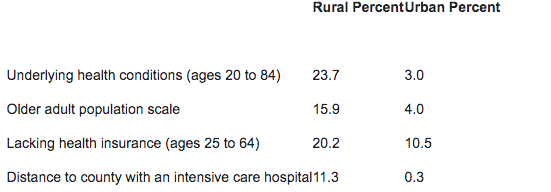ALBUQUERQUE, N.M., Feb. 25, 2021 – The United States Department of Agriculture (USDA) today announced it is investing $42.3 million to help rural residents gain access to health care and educational opportunities. Rural areas are seeing higher infection and death rates related to COVID-19 due to several factors, including a much higher percentage of underlying conditions, difficulty accessing medical care, and lack of health insurance. The $42.3 million in awards includes $24 million provided through the CARES Act. In total, these investments will benefit 5 million rural residents.
“The coronavirus pandemic is a national emergency that requires an historic federal response. These investments by the Biden Administration will help millions of people living in rural places access health care and education opportunities that could change and save lives,” said Agriculture Secretary Tom Vilsack. “USDA is helping rural America build back better using technology as a cornerstone to create more equitable communities. With health care and education increasingly moving to online platforms, the time is now to make historic investments in rural America to improve quality of life for decades to come.”
USDA is funding 86 projects through the Distance Learning and Telemedicine (DLT) grant program. The program helps rural education and health care entities remotely reach students, patients and outside expertise. These capabilities make world-class education and health care opportunities accessible in rural communities. The ability to use telehealth resources is critical, especially now during a global pandemic.
Fort Lewis College (FLC) in Durango, CO will use a $950,060 grant to strategically align technology that facilitates distance learning, improving access for roughly 3,270 students in the communities where they live. This HyFlex course design will be provided at four rural connectivity centers in La Plata and Conejos Counties in Colorado, Apache County in Arizona, and San Juan County in New Mexico. A HyFlex course design allows students to attend face-to-face classes, through synchronous sessions, fully online, allowing FLC to continue innovative delivering of quality education and support to students despite the continuing challenges presented by COVID-19.
“Bridging the digital divide for Fort Lewis College students is crucial to providing a quality education. This funding will allow for new technology for students to continue their studies and engage in remote learning with students and support staff on campus in real time,” said Acting New Mexico Rural Development State Director Eric Vigil.
The rural connectivity centers will help mitigate the digital divide for the learning communities that are most affected by digital inequities by providing rural students with the internet and technology necessary to fully engage in courses from afar. They will also allow students from each community to access their professors as well as fully engage with the services that students on-campus are able to access including the student health center, faculty office hours, academic support such as tutoring and library services, and student-run organizations.
A recent report by the Rural Policy Research Institute’s Center for Rural Health Policy Analysis found infection and death rates in rural America due to COVID-19 are 13.4 percent higher than in urban areas. A recent report from USDA’s Economic Research Service, USDA ERS - Rural Residents Appear to be More Vulnerable to Serious Infection or Death From Coronavirus COVID-19, underscored the challenges facing rural Americans amidst the COVID-19 pandemic with even greater detail. Due to a confluence of factors, including higher percentages of underlying conditions, lack of health insurance, and lower access to medical facilities/care than urban counterparts, ERS analysts found rural Americans are suffering more severe illness or death due to COVID-19.
Rural Residents Appear to be More Vulnerable to Serious Infection or Death from Coronavirus COVID-19

The table above is from the USDA ERS January 2021 report: Rural Residents Appear to be More Vulnerable to Serious Infection or Death from Coronavirus COVID-19
In January, President Biden requested all parts of the federal government to contribute resources to contain the coronavirus pandemic. USDA is responding to the President’s call to action. To date, more than 350 USDA personnel have deployed to assist with standing up vaccination sites, for example. In addition to personnel, USDA is offering its facilities, cold chain infrastructure, public health experts, disaster response specialists, and footprint in rural and Tribal communities across the country. USDA’s commitment to control the pandemic extends to our own staff and facilities, with masking and physical distancing requirements across USDA, a commitment to provide PPE to our front-line workers, and working with states to prioritize vaccinations for our workforce. For more information, visit www.usda.gov/coronavirus. USDA also encourages people seeking health insurance to go to HealthCare.gov now through May 15th due to a special enrollment period. If you are recently uninsured due to a job loss or between jobs, find a plan at HealthCare.gov and keep it for as long as you need it.
USDA Rural Development provides loans and grants to help expand economic opportunities and create jobs in rural areas. This assistance supports infrastructure improvements; business development; housing; community facilities such as schools, public safety and health care; and high-speed internet access in rural areas. For more information, visit www.rd.usda.gov/nm.
USDA touches the lives of all Americans each day in so many positive ways. In the Biden-Harris Administration, USDA is transforming America’s food system with a greater focus on more resilient local and regional food production, ensuring access to healthy and nutritious food in all communities, building new markets and streams of income for farmers and producers using climate-smart food and forestry practices, making historic investments in infrastructure and clean energy capabilities in rural America, and committing to equity across the Department by removing systemic barriers and building a workforce more representative of America. To learn more, visit www.usda.gov.


